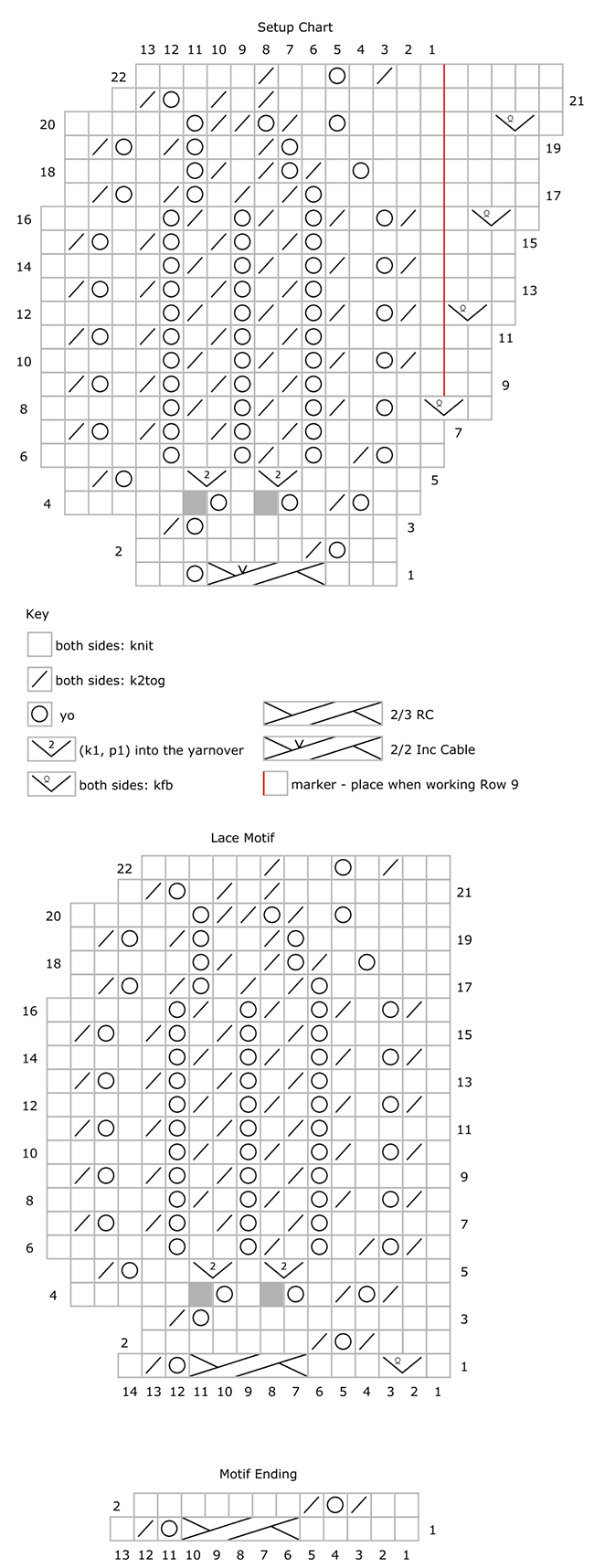Baroque Shawl, a free knitting pattern from Knitty.com.
INTRODUCTION
Smokestacks
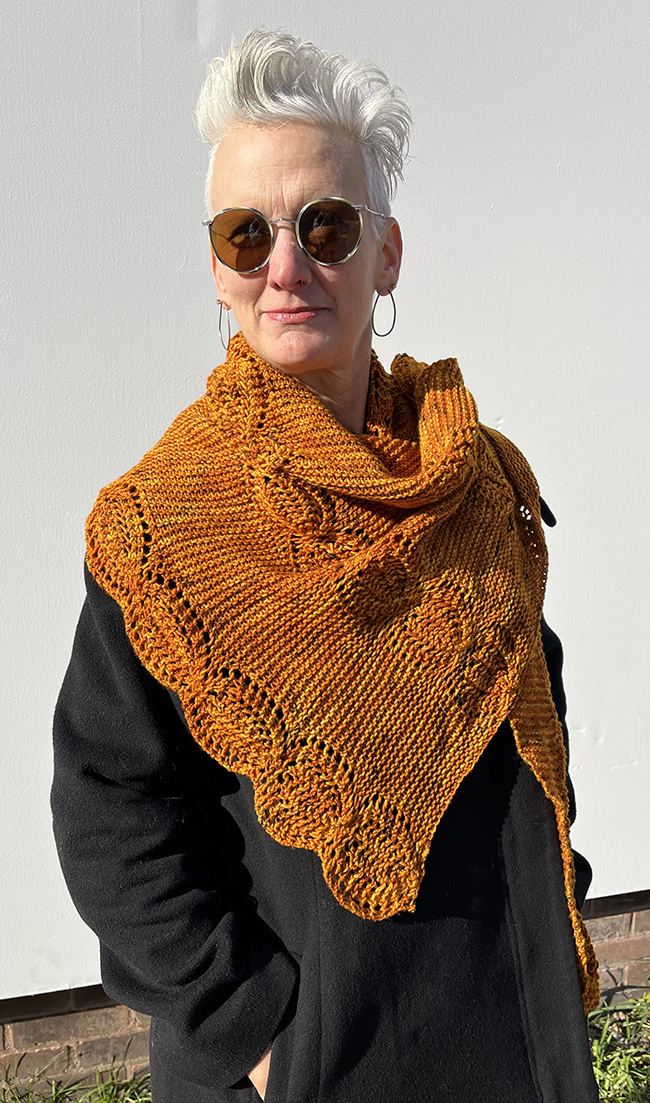 by Kate Atherley
by Kate Atherley
![]()
Love lace? Love cables? Why choose! This stitch pattern offers both. It's a slight variation of an old edging pattern, identified as "The Portuguese Edging" in many books. I've adapted it so it works in the middle of rows, not just at the end.
This asymmetrical triangle is my favourite type of shawl shape: cast on a small number of stitches and work until the yarn is done, it’s the right size, or you’re just ready to move onto something else.
It uses two-side lace, that is, there are yarnovers and decreases worked on both right and wrong sides. This does up the difficulty level a little, in that mistakes in the lace are harder to fix – but liberal use of lifelines and careful counting of rows should keep you on track.
The cable is somewhat unusual, as it is worked in garter stitch; the wrong-side row following the cable cross is knit rather than purled. The cable is here is used here to create shape and enhance the curve, rather than for the usual decorative reasons.
In another non-traditional move, I've worked this shawl in a thicker-than-usual yarn: a gorgeous squishy worsted weight. In the depths of winter, I like a substantial shawl – and the larger scale shows off the stitch pattern even better. You're welcome to use any type of yarn you wish, of course… but I bet you might appreciate the extra warmth this brings. I’ve included instructions for adjusting for a different yardage.
 model: Claudia B Manley
model: Claudia B Manley
 photos: Amy Singer
photos: Amy Singer
SIZE
One
Note: See pattern notes for details on adjusting to a different gauge or yardage.
FINISHED MEASUREMENTS
Width at top edge: 70 inches/178 cm
Depth: 28 inches/71 cm
MATERIALS
Yarn
![]() Lucky Violet Color Co Mindy [100% superwash merino; 218 yd/200 m per 100 g skein]; color: Hidden Treasures; 3 skeins
Lucky Violet Color Co Mindy [100% superwash merino; 218 yd/200 m per 100 g skein]; color: Hidden Treasures; 3 skeins
Yarn Characteristics
![]() The yarn used for this project is a hand-dyed, eight-ply superwash merino. It's plushy and springy, and responds very well to a stretch blocking. To show off the patterning to best effect, you need a color that contrasts well with the coat you're wearing it over, and something with tonal color changes, in the same color family. This particular yarn has a few speckles but it's not very busy; a too-busy colorway would obscure the lace motif.
The yarn used for this project is a hand-dyed, eight-ply superwash merino. It's plushy and springy, and responds very well to a stretch blocking. To show off the patterning to best effect, you need a color that contrasts well with the coat you're wearing it over, and something with tonal color changes, in the same color family. This particular yarn has a few speckles but it's not very busy; a too-busy colorway would obscure the lace motif.
Recommended needle size
[always use a needle size that gives you the gauge listed below - every knitter's gauge is unique]
![]() US #7/4.5 mm needles for working flat – recommend a 24 inch/60 cm or longer circular needle
US #7/4.5 mm needles for working flat – recommend a 24 inch/60 cm or longer circular needle
Notions
![]() stitch markers
stitch markers
![]() blocking mats, pins, wires and/or combs
blocking mats, pins, wires and/or combs
![]() cable needle
cable needle
![]() yarn needle
yarn needle
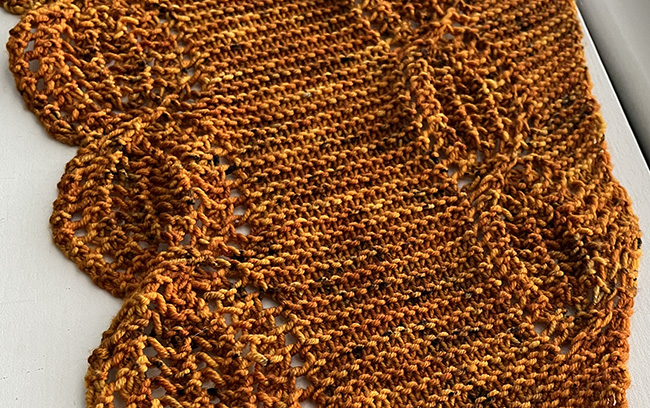
GAUGE
20 sts/28 rows = 4 inches/10 cm in stockinette stitch after blocking
16 sts/28 rows = 4 inches/10 cm in garter stitch after blocking
Note: that gauge is not crucial for the finished project, although working at a different gauge may affect finished size and yardage.
PATTERN NOTES
[Knitty's list of standard abbreviations and techniques can be found here.]
Tip: I found that the biggest challenge was keeping track of which row I was on in the center section of the Lace Motif: Rows 7-8 are repeated 4 times, and it's easy to get distracted in this section. I found it helpful to count up the yarnovers worked in the central columns, directly above the cable cross.
On Resizing:
You can make this shawl smaller or larger as you prefer. You do need to finish at a certain point in the patterning, but you can work more or fewer stripes. I've noted in the pattern where you can stop or add more length.
CHARTS
Important Note: The Lace Motif is worked on a garter stitch background – that is, WS rows are knit. To simplify the chart, I've used the old Shetland standard for the symbols: they are read and worked the same way on both sides. That is, a blank square is worked as a knit on both sides, the decrease is always worked as a k2tog, and so forth. Please do check the chart key.
The stitch count changes in the Lace Motif, so stitch counts are only given for the garter sections.
2/3 RC: Slip 3 sts to cable needle and hold at back of work; k2, then k3 from cable needle.
2/2 Inc Cable: Slip 2 sts to cable needle and hold at back of work; k2, then kfb, k1 from cable needle. 4 stitches increased to 5.
DIRECTIONS
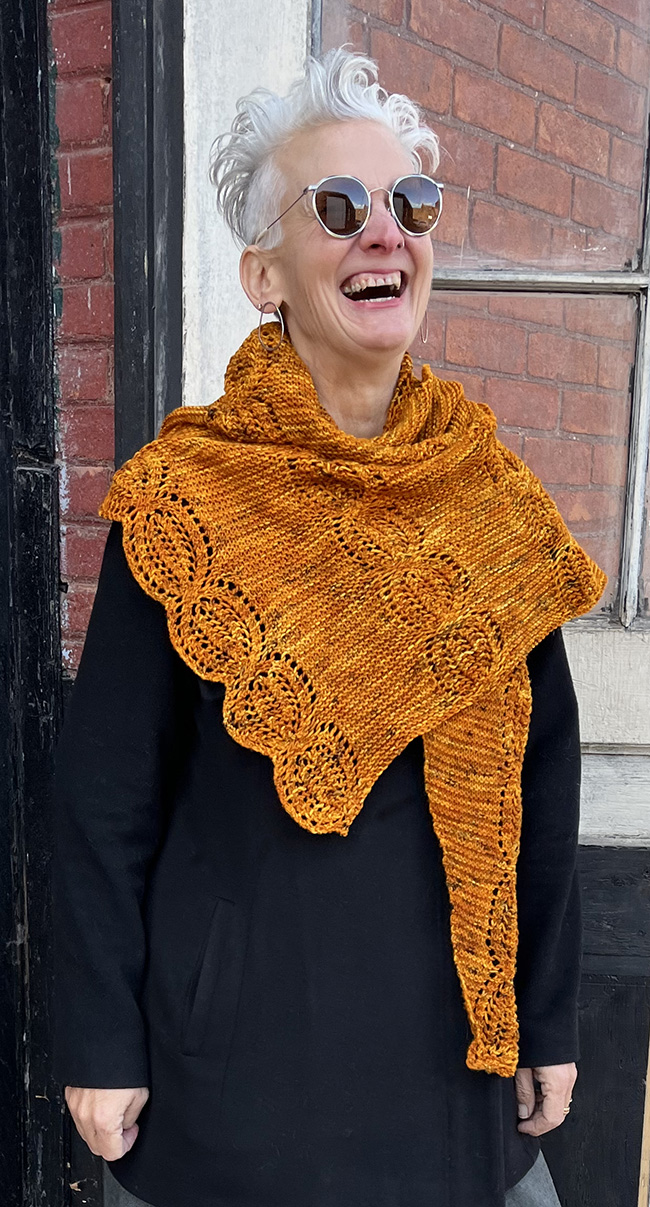
Section One
Cast on 9 stitches.
Knit 1 row.
Work the Setup chart, placing a marker after the second stitch on Row 9, as indicated by the red line in the chart.
Section Two
Row 1 [RS]: Knit to marker, work Lace Motif to end of row.
Row 2 [WS]: Work Lace Motif to marker, knit to last 2 sts, kfb, k1. 1 st increased in garter section at right-hand side of shawl (when looking at right side).
Work as set until you have completed two repeats of the Lace Motif, and Rows 1-21 of a third AT THE SAME TIME working a kfb increase as set on Row 2 every 4th row. That is, you'll work the increase on Rows 2, 6, 10, 14, 18 and 22 of the first repeat, on Rows 4, 8, 12, 16 and 20 of the second repeat, and on Rows 2, 6, 10, 14, 18 of the third repeat.
Final row of this section (WS): Work Row 22 of Lace Motif to marker, knit to last 2 sts, yo, k2. 1 st increased in garter section at right-hand side of shawl (when looking at right side).
When this section is complete, you will have 22 stitches at the start of the row before the marker.
Section Three
Row 1 [RS]: Work the Setup chart across the first 9 sts, place marker, knit to next marker, work Lace Motif as set to end of row.
Row 2 [WS]: Work Lace Motif to first marker, knit to second marker, work Setup chart to end of row.
Continue to work as set until you have completed the Setup chart, placing another marker after the second stitch on Row 9, as indicated by the red line in the chart.
Section Four
Row 1 [RS]: [Knit to marker, work Lace Motif] twice.
Row 2 [WS]: Work Lace Motif, knit to marker, work Lace motif, knit to last 2 sts, kfb, k1. 1 st increased in garter section at right-hand side of shawl (when looking at right side).
Work as set until you have completed two repeats of the Lace Motif, and Rows 1-21 of a third, working an increase as set on Row 2 every 4th row. As before, you'll work the increase on Rows 2, 6, 10, 14, 18 and 22 of the first repeat, on Rows 4, 8, 12, 16 and 20 of the second repeat, and on Rows 2, 6, 10, 14, 18 of the third repeat.
Final row of this section (WS): Work Row 22 of Lace Motif, knit to marker, work Lace motif, knit to last 2 sts, yo, k2. 1 st increased.
When this section is complete, you will have 22 stitches at the start of the row, before the first marker.
Section Five
Row 1 [RS]: Work the Setup chart across the first 9 sts, place marker, [knit to next marker, work Lace Motif] twice.
Row 2 [WS]: [Work Lace Motif to marker, knit to next marker] twice, work Setup chart to end of row.
Continue to work as set until you have completed the Setup chart, placing another marker after the second stitch on Row 9, as indicated by the red line in the chart.
Section Six
Row 1 [RS]: [Knit to marker, work Lace Motif] three times.
Row 2 [WS]: [Work Lace Motif, knit to next marker] twice, work Lace motif, knit to last 2 sts, kfb, k1. 1 st increased.
Work as set until you have completed two repeats of the Lace Motif, and Rows 1-21 of a third, working an increase as set on Row 2 every 4th row. As before, you'll work the increase on Rows 2, 6, 10, 14, 18 and 22 of the first repeat, on Rows 4, 8, 12, 16 and 20 of the second repeat, and on Rows 2, 6, 10, 14, 18 of the third repeat.
Final row of this section (WS): [Work Row 22 of Lace Motif, knit to next marker] twice, work Row 22 of Lace motif, knit to last 2 sts, yo, k2. 1 st increased.
When this section is complete, you will have 22 stitches at the start of the row, before the first marker.
Note: If the shawl is nearing the size you want, or you're nearly out of yarn, you can skip the next two sections and proceed to the final section.
Section Seven
Row 1 [RS]: Work the Setup chart across the first 9 sts, place marker, [knit to next marker, work Lace Motif] three times.
Row 2 [WS]: [Work Lace Motif to marker, knit to next marker] three times, work Setup chart to end of row.
Continue to work as set until you have completed the Setup chart, placing another marker after the second stitch on Row 9, as indicated by the red line in the chart.
Section Eight
Row 1 [RS]: [Knit to marker, work Lace Motif] four times.
Row 2 [WS]: [Work Lace Motif, knit to marker] three times, work Lace motif, knit to last 2 sts, kfb, k1. 1 st increased.
Work as set until you have completed two repeats of the Lace Motif, and Rows 1-21 of a third, working an increase as set on Row 2 every 4th row. As before, you'll work the increase on Rows 2, 6, 10, 14, 18 and 22 of the first repeat, on Rows 4, 8, 12, 16 and 20 of the second repeat, and on Rows 2, 6, 10, 14, 18 of the third repeat.
Note: the increase on the final row is different than for previous sections.
Final row of this section (WS): [Work Row 22 of Lace Motif, knit to marker] three times, work Row 22 of Lace motif, knit to last 2 sts, kfb, k1. 1 st increased.
When this section is complete, you will have 22 stitches at the start of the row, before the first marker.
Note: If you've got more yardage or are working with a finer yarn and want to make the shawl bigger, you can continue as set, adding another repeat of the Lace Motif. If you do that, you'll work five repeats of the pattern in the Final section, rather than four.
Final Section
Row 1 [RS]: [Knit to marker, work Motif Ending chart] four times
Row 2 [WS]: [Work Lace Motif, knit to marker] four times.
With RS facing, bind off as follows: K1, *k1, return both sts to left needle and knit them tog-tbl; repeat from * until all sts have been worked. Cut yarn and pull through final st to secure.
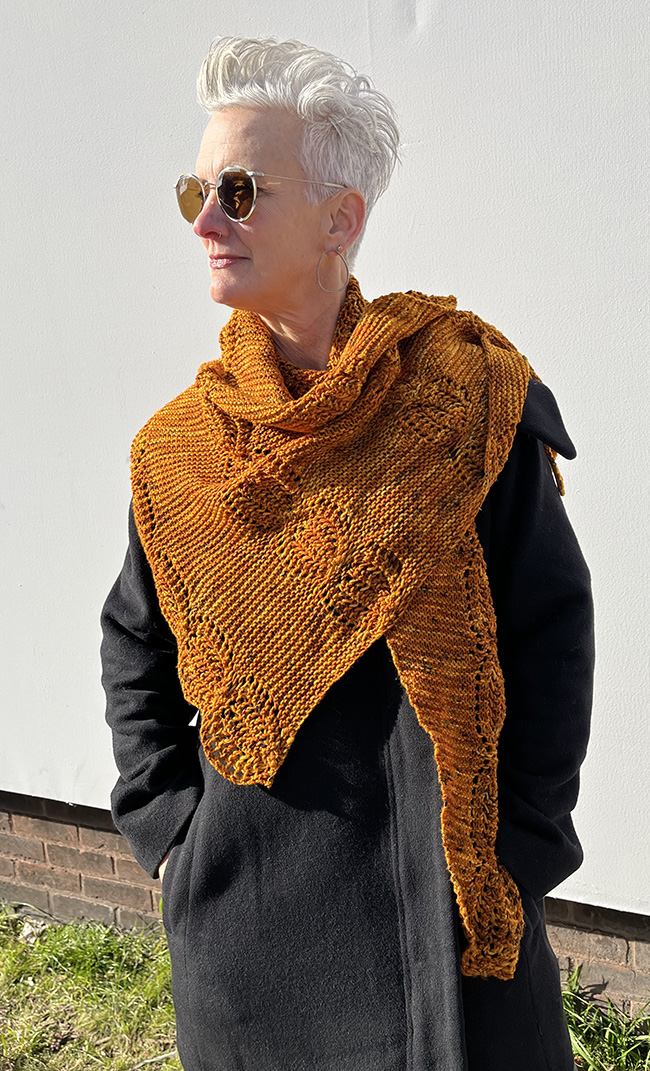
FINISHING
This shawl really benefits from being stretched and pinned out. Soak in lukewarm water with a wool wash, and then squeeze out the moisture by rolling in towels or send through the spin cycle of your washing machine. If you're using the project yarn which is superwash, a gentle machine wash is fine, and covers both steps!
Then pin out the shawl, stretching it to open up the lace motifs and enhancing the scallops along the lower edge, and at the top edge where a new lace motif starts.
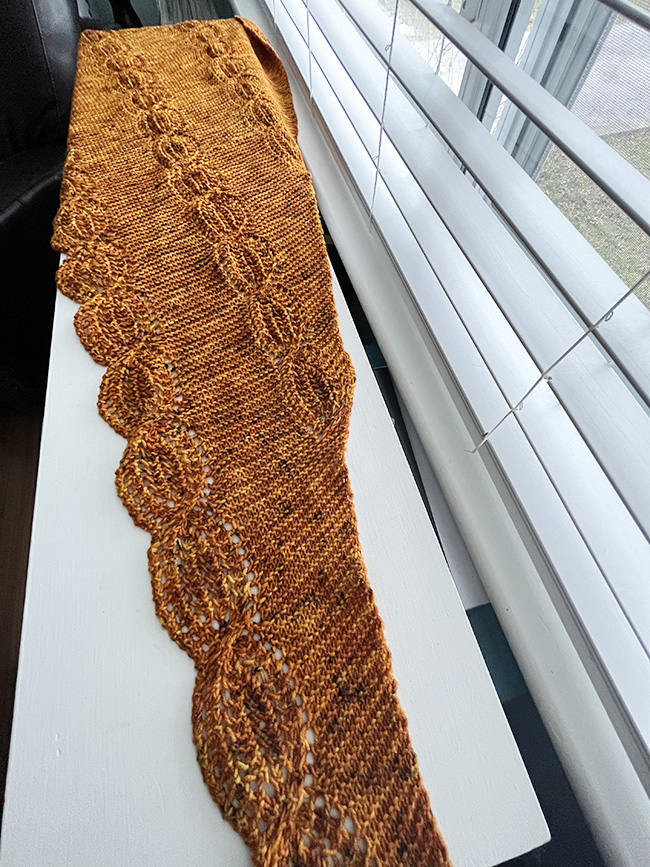
ABOUT THE DESIGNER
 Kate lives in Toronto, which gets pretty darn cold in the winter, so she very much appreciates a generously-sized shawl. She loves shawl knitting so much she wrote a whole book about it.
Kate lives in Toronto, which gets pretty darn cold in the winter, so she very much appreciates a generously-sized shawl. She loves shawl knitting so much she wrote a whole book about it.
Find out more about Kate at kateatherley.com
Pattern & images © 2021 Kate Atherley
